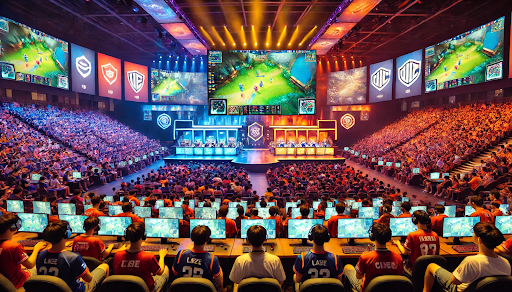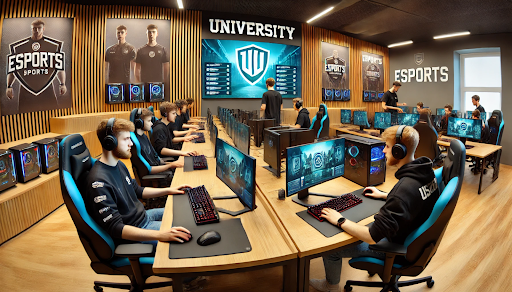News/Commentary
- College Football Gets Limited 2024 Debut This Saturday
- 2024 Conference Standings Predictions - Comparing Computer to the Media/Coaches Polls
- How UK Casinos Appeal to Sports Fans: Strategies and Tactics
- The Rise of Collegiate Esports: Universities Embracing Gaming
- 2024 Projected FBS Standings, Rankings, Playoff Teams, Champion
- Aaron Judge Becomes Fastest To 300 Homers
- 2024 Butkus Award Preseason Watch List
The Rise of Collegiate Esports: Universities Embracing Gaming
August 16, 2024 by Staff
Esports has emerged from the periphery of the gaming world to become a significant player in the realm of competitive sports, particularly at the collegiate level. Universities across the globe are not only acknowledging the popularity and influence of esports but are actively integrating it into their athletic programs, curriculums, and campus life. This article delves into the rise of collegiate esports, highlighting the developments, impacts, and future prospects of this dynamic and rapidly evolving field. One of the most comprehensive sources for esports news is https://www.vpesports.com/, which provides in-depth coverage of the latest trends, tournaments, and developments in the esports world.

The Evolution of Collegiate Esports
Historical Context
Collegiate esports has grown remarkably since its informal inception. Initially, college gaming clubs and informal tournaments were the primary platforms for competitive gaming. Over time, as the popularity of esports surged, universities began to see the potential for structured programs.
Formalization and Structure
In recent years, organizations such as the National Association of Collegiate Esports (NACE) and the Collegiate Starleague (now Playfly College Esports) have provided the necessary structure and governance. This formalization has led to the creation of varsity esports teams, scholarships, and dedicated esports facilities on campuses across North America.
- NACE: Established in 2016, NACE has become the largest collegiate esports association in North America, with over 170 member schools. It oversees varsity programs and offers guidance on best practices and governance.
- Playfly College Esports: Rebranded from NACE Starleague, Playfly College Esports supports various game titles at both varsity and open levels, hosting competitions like the Collegiate Chess League and the eNASCAR College iRacing Series.
Rapid Growth and Integration
The integration of esports into university programs has been swift and widespread. Here are some key milestones and statistics:
- Number of Programs: As of 2024, over 200 universities in North America have established varsity esports programs.
- Scholarships: Approximately $16 million in scholarships were awarded to esports athletes in 2023 alone.
- Dedicated Facilities: Many universities have invested in state-of-the-art esports arenas. For example, the Esports Stadium Arlington is the largest dedicated esports facility in North America, frequently hosting significant collegiate events.
Impact on Students and Campus Life
Academic and Career Opportunities
Collegiate esports programs offer students more than just a chance to compete. They open doors to academic and career opportunities in a rapidly growing industry.
- Curriculum Integration: Universities like the University of California, Irvine, have developed academic programs focused on esports management, game design, and digital media.
- Career Pathways: Graduates can pursue careers in game development, event management, marketing, and broadcasting within the esports industry.
Community and Inclusivity
Esports fosters a sense of community and inclusivity, appealing to a diverse student body. Unlike traditional sports, esports is accessible to a broader range of participants, including those who might not engage in conventional athletic programs.
- Diversity Initiatives: Programs are actively working to increase diversity within esports. For example, many universities have initiatives to support women and underrepresented minorities in gaming.
- Community Building: Gaming clubs and esports teams provide a platform for social interaction, teamwork, and a shared sense of purpose among students.
Major Collegiate Esports Events
Collegiate Esports Commissioner’s Cup (CECC)
The CECC is one of the premier collegiate esports events, attracting top teams from across the country. The 2024 event, held in Arlington, Texas, featured 84 teams competing across four game titles. It included middle and high school championships, making it a comprehensive scholastic esports festival.
- Scale and Scope: The CECC Texas 2023 event drew over 3,000 fans and featured 443 athletes from 64 teams across 14 conferences.
- Activities and Engagement: The event includes vendor villages, partner activations, cosplay contests, and esports celebrity meet-and-greets, creating a festival-like atmosphere.
Playfly College Esports Tournaments
Playfly College Esports, which oversees several collegiate tournaments, offers extensive support and opportunities for student-athletes.
- Scholarships and Prizes: Over $150,000 in scholarship prizing is available, with additional rewards for top-performing teams.
- Weekly Broadcasts and LAN Finals: Regular broadcasts and an annual LAN Grand Finals event provide continuous engagement and high-stakes competition.
The Future of Collegiate Esports
Technological Advancements
As technology evolves, so too will the landscape of collegiate esports. Virtual reality (VR) and augmented reality (AR) are poised to become integral components of the esports experience, offering immersive gaming environments that could revolutionize training and competition.
Expanding Global Reach
While North America has been a leader in collegiate esports, other regions are catching up. Universities in Europe and Asia are developing robust esports programs, leading to increased international competition and collaboration.
Enhanced Support and Resources
Universities are increasingly recognizing the need for comprehensive support systems for esports athletes. This includes mental health resources, nutritional guidance, and academic support to ensure that students can balance their studies with their esports commitments.
Professional Pathways
The connection between collegiate esports and professional leagues is strengthening. Successful collegiate players are often scouted by professional teams, providing a clear pathway from university competition to a professional esports career.
Partnerships and Sponsorships
Corporate sponsorships and partnerships play a crucial role in the growth of collegiate esports. Companies like McDonald’s, which has been a significant sponsor of the CECC, provide financial support and resources that help elevate the level of competition and exposure for collegiate esports.
Conclusion
The rise of collegiate esports represents a significant shift in how universities engage with sports and student life. By embracing gaming, universities are not only catering to the interests of a new generation of students but also providing them with valuable skills and opportunities. As collegiate esports continues to grow and evolve, it will undoubtedly leave a lasting impact on higher education and the broader esports landscape.
